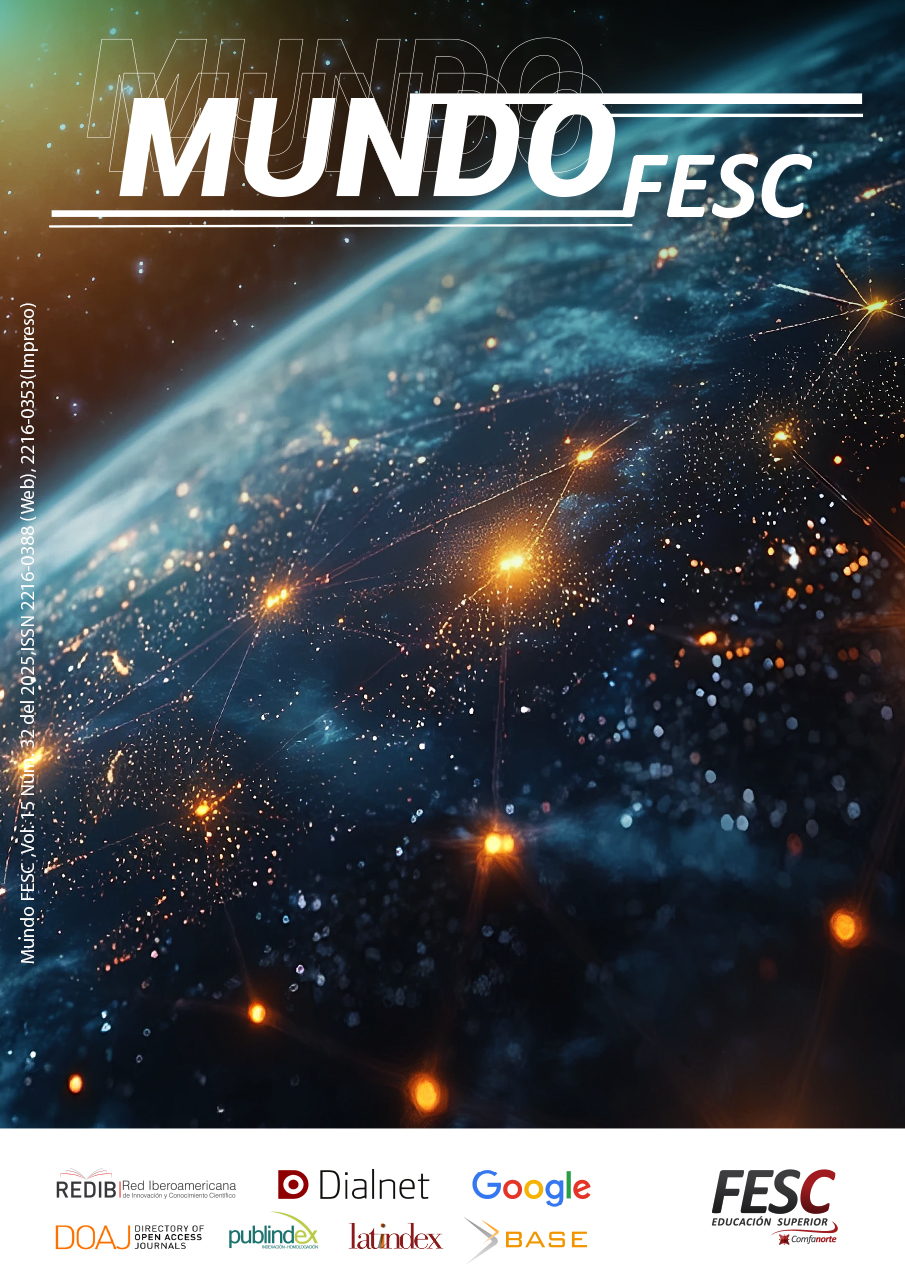Calculation of the carbon footprint of the water treatment process at the el Pórtico and el Carmen de Tonchalá plants, Aguas Kpital company - E.S.P (Cúcuta), year 2023
DOI:
https://doi.org/10.61799/2216-0388.1769Keywords:
Carbon Footprint, Ecoinvent 3.10 Database, Iso 14067 Standard, Kpital - Esp Cúcuta Waters, Pas 2050Abstract
The determination of the carbon footprint of a production process makes it possible to address the environmental impact generated in order to comply with current environmental regulations and take action in this regard. This work shows the results obtained in the calculation of the carbon footprint of the water treatment process of the water treatment company Kpital – ESP Cúcuta, for the year 2023. The methodology used includes the evaluation of the impact by determining the of the life cycle assessment and interpreting it for the selected process. For the calculation of the life cycle assessment, the ISO 14067, PAS 2050 and GHG Protocol - Product Standard were applied in a combined way and for the calculation of the carbon footprint the OpenLCA 2.1 program and the ecoinvent 3.10 database were used. The average values obtained were 1,704,473.37 kg CO2-eq. and 958,698.873 kg CO2-eq for the el Pórtico and Carmen de Tonchalá plants, respectively.
Downloads
References
[1] J. E. Pinto Hernández y M. Salazar de Cardona, “Cambio climático y vulnerabilidad: prospectivas para la región nororiental de Colombia - Santanderes,” BISTUA: Revista de la Facultad de Ciencias Básicas, vol. 12, no. 1, pp. 16–45, 2014. DOI: https://doi.org/10.22490/25391887.1156
[2] IDEAM, Inventario Nacional de Gases de Efecto Invernadero: Tercer Informe Bienal de Actualización de Colombia ante la CMNUCC. Bogotá, Colombia: Instituto de Hidrología, Meteorología y Estudios Ambientales (IDEAM), 2021.
[3] K. Marvel, W. Su, R. Delgado, S. Aarons, A. Chatterjee, M. E. Garcia, Z. Hausfather, K. Hayhoe, D. A. Hence, E. B. Jewett, A. Robel, D. Singh, A. Tripati, and R. S. Vose, “Ch. 2. Climate trends,” in Fifth National Climate Assessment, A. R. Crimmins, C. W. Avery, D. R. Easterling, K. E. Kunkel, B. C. Stewart, and T. K. Maycock, Eds. Washington, DC, USA: U.S. Global Change Research Program, 2023. DOI: https://doi.org/10.7930/NCA5.2023.CH2
[4] L. M. G. Contreras, “Evolución de la política de cambio climático en Colombia,” Vniversitas, vol. 69, pp. 1–17, 2020. doi: https://doi.org/10.11144/Javeriana.vj69.epcc DOI: https://doi.org/10.11144/Javeriana.vj69.epcc
[5] Ministerio de Ambiente y Desarrollo Sostenible, “Inventario de Gases de Efecto Invernadero – GEI,” Bogotá, Colombia, Marzo 2024. [En línea]. Disponible en: https://www.minambiente.gov.co/cambio-climatico-y-gestion-del-riesgo/inventario-de-gases-de-efecto-invernadero-gei/#tabs-1
[6] C. M. Lubo Cetina, L. M. Rodríguez Pérez, A. P. Jiménez Escobar y A. López Astudillo, Huella de carbono – Dinámica de sistemas – Calidad, Cali, Colombia: Editorial Universidad Icesi, 2019.
[7] P. Granda, “ISO 14040 como marco de referencia del Análisis del Ciclo de Vida,” Envira, Febrero 2024. [En línea]. Disponible en: https://envira.es/es/iso-14040-principios-relacionados-gestion-ambiental/
[8] C. Espíndola y J. O. Valderrama, “Huella del carbono. Parte 1: conceptos, métodos de estimación y complejidades metodológicas,” Información Tecnológica, vol. 23, no. 1, pp. 163–176, ene. 2012. doi: https://doi.org/10.4067/S0718-07642012000100017 DOI: https://doi.org/10.4067/S0718-07642012000100017
[9] Agencia de Protección Ambiental de los Estados Unidos (US EPA), “Understanding Global Warming Potentials,” 4 de enero de 2025. [En línea]. Disponible en: https://www.epa.gov/ghgemissions/understanding-global-warming-potentials
[10] Our World in Data, “Global warming potential of greenhouse gases relative to CO₂,” 6 de noviembre de 2023. [En línea]. Disponible en: https://ourworldindata.org/grapher/global-warming-potential-of-greenhouse-gases-over-100-year-timescale-gwp
[11] ICONTEC, NTC-ISO 14040:2022 – Gestión ambiental. Análisis de ciclo de vida. Principios y marco de referencia, Instituto Colombiano de Normas Técnicas y Certificación, Bogotá, NTC-ISO 14040:2022, 2022. [En línea]. Disponible en: https://tienda.icontec.org/gp-ntc-iso-gestion-ambiental-analisis-de-ciclo-de-vida-principios-y-marco-de-referencia-ntc-iso14040-2022.html
[12] International Organization for Standardization, ISO 14067:2018 – Greenhouse gases – Carbon footprint of products – Requirements and guidelines for quantification, 2018. [En línea]. Disponible en: https://www.iso.org/standard/71206.html
[13] British Standards Institution, PAS 2050:2011 – Specification for the assessment of the life cycle greenhouse gas emissions of goods and services, 2011. [En línea]. Disponible en: https://knowledge.bsigroup.com/products/specification-for-the-assessment-of-the-life-cycle-greenhouse-gas-emissions-of-goods-and-services
[14] World Resources Institute y World Business Council for Sustainable Development, Greenhouse Gas Protocol: Product Life Cycle Accounting and Reporting Standard, 2011. [En línea]. Disponible en: https://ghgprotocol.org/sites/default/files/standards/Product-Life-Cycle-Accounting-Reporting-Standard_041613.pdf
[15] ecoinvent, ecoinvent v3.10 – Data with purpose, 28 de noviembre de 2023. [En línea]. Disponible en: https://ecoinvent.org/ecoinvent-v3-10/
[16] Aguas Kpital Cúcuta S.A. E.S.P., “Planta de tratamiento | Aguas Kpital Cúcuta S.A. E.S.P.,” 2017. [En línea]. Disponible en: https://akc.com.co/web/plantas-de-tratamiento/
[17] A. Díaz, “Determinación de Huella de Carbono para los procesos de potabilización en las plantas El Pórtico y Carmen de Tonchalá en la empresa Aguas Kpital Cúcuta S.A. E.S.P.”, Trabajo de grado, Univ. de Pamplona, 2018. [En línea]. Disponible en: http://repositoriodspace.unipamplona.edu.co/jspui/bitstream/20.500.12744/8430/1/Diaz_2019_TG.pdf
[18] A. M. Verdugo Rojas, H. U. Rivera Alarcón, y E. G. Flórez Serrano, “Determinación de la huella de carbono mediante el análisis de ciclo de vida, Caso de Estudio: Edificio Administrativo de una Empresa de Servicios Públicos,” Mundo FESC, vol. 13, no. S2, pp. 23–37, 2023. doi: https://doi.org/10.61799/2216-0388.1653
[19] M. L. Barrera Pérez, O. A. Ávila, y L. Beleño Montagut, “Estimación del potencial de calentamiento global en un sistema de potabilización de un acueducto municipal en Colombia,” BISTUA Rev. Fac. Cienc. Básicas, vol. 18, no. 1, pp. 11–16, nov. 2020. doi: https://doi.org/10.24054/bistua.v18i1.206 DOI: https://doi.org/10.24054/01204211.v1.n1.2020.206
[20] P. T. Otálora Torres, “Elaboración del procedimiento para el cálculo de la huella de carbono empresarial de Enel Colombia,” trabajo de grado, Univ. El Bosque, Bogotá, Colombia, 2022.
Downloads
Published
Issue
Section
License
Copyright (c) 2025 Mundo FESC Journal

This work is licensed under a Creative Commons Attribution-NonCommercial 4.0 International License.






